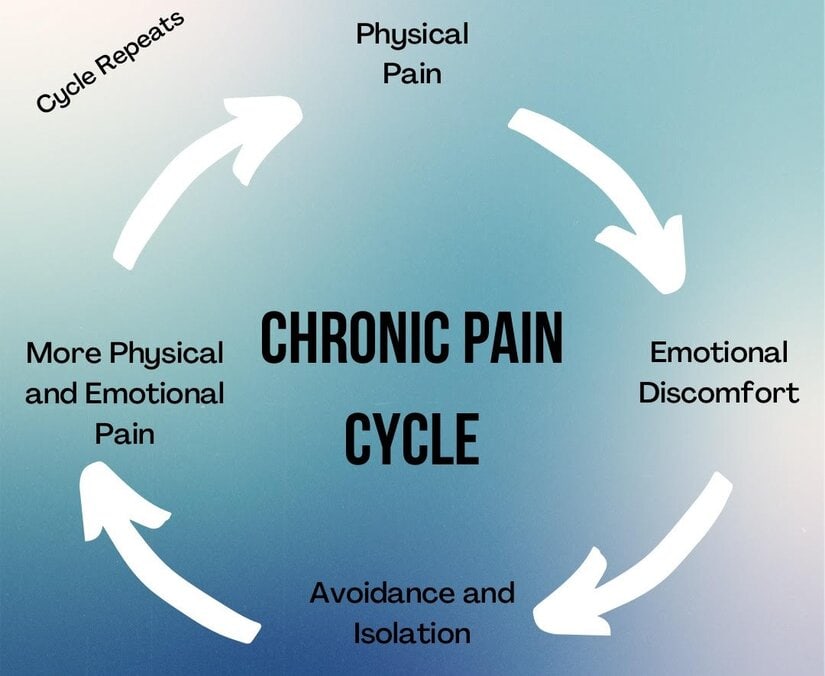Accepting Chronic Pain

Resistance can be a beneficial thing when it comes to exercising with weights or standing up for yourself or someone else when it relates to bullying or outright injustice. But what happens when we resist chronic pain?
By all rights, chronic pain can feel like a true violation against the way we want to live, but the pain itself is telling us something. By taking time to listen to our bodies, offering acceptance and creating support instead of fighting it, we may uncover some relief.
What is Chronic pain cycle
The chronic pain cycle is a self-perpetuating pattern in which chronic pain leads to decreased physical activity, disrupted sleep, and emotional distress (such as depression and anxiety), which in turn can worsen pain.
Breaking the cycle involves addressing each component through physical therapy, psychological support, pain management techniques, and lifestyle changes. Effective management of the chronic pain cycle can improve quality of life and reduce the experience of pain.
The chronic pain cycle is a vicious cycle that can occur in people who experience persistent pain. It typically involves the following stages:
- Pain: Chronic pain is the starting point and the ongoing source of discomfort.
- Depression: Pain can lead to depression and feelings of hopelessness.
- Anxiety: The fear of further pain or disability can cause anxiety and worry.
- Sleeping problems: Chronic pain can disrupt sleep patterns and lead to insomnia.
- Decreased activity: Reduced physical activity can lead to increased deconditioning and decreased mobility.
- Increased pain: Decreased activity and deconditioning can lead to increased muscle tension, joint stiffness, and further pain.
This cycle can be difficult to break, but by addressing each component, such as through physical therapy, psychological support, and pain management techniques, individuals can improve their quality of life and reduce their experience of chronic pain.
Consequences
Because chronic pain can cause serious frustration and even anger, first know that your body does not want to be in pain. These messages of pain are being sent for a reason. In fact, your body actually wants to heal! So by believing this, the first layer of resistance is removed.
Acceptance of “what is” can create a nice space in which to offer yourself healing through love. Instead of shaming yourself or blaming your body, breathing exercises offering admission and allowance of the messages you receive can help calm and soothe.
Finally, take time to uncover what support your body needs. Consuming healthy, nourishing foods and supplements are one way in which you can help address the pain. The better you fuel and treat your body, the more it can begin to strengthen and heal. Also, do you reach out for help when needed? Surrounding yourself with caring folks who are more than happy to assist can take a big burden off of your shoulders, so to speak.
Tips to Learn to Accept Chronic Pain
Mindfulness and relaxation techniques
Practice mindfulness, deep breathing, and progressive muscle relaxation to help manage pain and reduce stress.
Set realistic goals
Accept that chronic pain may limit certain activities, and focus on what you can do, rather than what you can’t.
Engage in physical activity
Regular exercise, such as walking, swimming, or yoga, can help reduce pain, increase flexibility, and improve overall physical and mental well-being.
Seek support
Join a support group, talk to friends and family, or consider therapy to help cope with chronic pain.
Prioritize self-care
Get enough sleep, eat a balanced diet, and take time for hobbies and activities that bring you joy.
Be open to new treatments
Try different pain management techniques, such as acupuncture, massage, or physical therapy, to find what works best for you.
Re-frame your thoughts
Try to shift your focus from the pain to the present moment and what you are grateful for.
By accepting and managing chronic pain, you can improve your quality of life and reduce its impact on daily activities.
Find little ways to be happy
Does a small, physical stretch, however you are able, feel good? Wonderful! Make a habit of it. If a certain type of moment aggravates your body, skip it for sure, but choose the ones that actually provide healing energy.
A support system in all ways, beginning with the mental messages you send yourself can have a large impact on your chronic pain. Your protocol may involve a support group or just a good laugh with a friend, so whatever you choose on any particular day should be filled with love for yourself. Having a smorgasbord board of options for pain management is key, as it’s not a one-size fits all approach. Breathe in life, one moment at a time.









